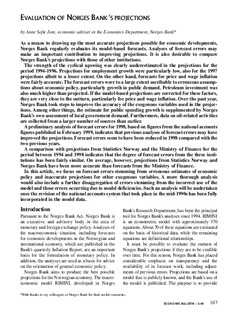| dc.description.abstract | As a means to drawing up the most accurate projections possible for economic developments, Norges Bank regularly evaluates its model-based forecasts. Analyses of forecast errors may make an important contribution to improving projections. It is also desirable to compare Norges Bank's projections with those of other institutions. The strength of the cyclical upswing was clearly underestimated in the projections for the period 1994-1996. Projections for employment growth were particularly low, also for the 1997 projections albeit to a lesser extent. On the other hand, forecasts for price and wage inflation were fairly accurate. The forecast errors were to a large extent ascribable to erroneous assumptions about economic policy, particularly growth in public demand. Petroleum investment was also much higher than projected. If the model-based projections are corrected for these factors, they are very close to the outturn, particularly for price and wage inflation. Over the past year, Norges Bank took steps to improve the accuracy of the exogenous variables used in the projections. Among other things, the estimate for public spending growth is supplemented by Norges Bank’s own assessment of local government demand. Furthermore, data on oil-related activities are collected from a larger number of sources than earlier. Apreliminary analysis of forecast errors for 1998, based on figures from the national accounts figures published in February 1999, indicates that previous analyses of forecast errors may have improved the projections. Forecast errors seem to have been reduced in 1998 compared with the two previous years. A comparison with projections from Statistics Norway and the Ministry of Finance for the period between 1994 and 1998 indicates that the degree of forecast errors from the three institutions has been fairly similar. On average, however, projections from Statistics Norway and Norges Bank have been more accurate than forecasts from the Ministry of Finance. In this article, we focus on forecast errors stemming from erroneous estimates of economic policy and inaccurate projections for other exogenous variables. A more thorough analysis would also include a further disaggregation of errors stemming from the incorrect use of the model and those errors occurring due to model deficiencies. Such an analysis will be undertaken once the revision of the national accounts system that took place in the mid-1990s has been fully incorporated in the model data. | nb_NO |

